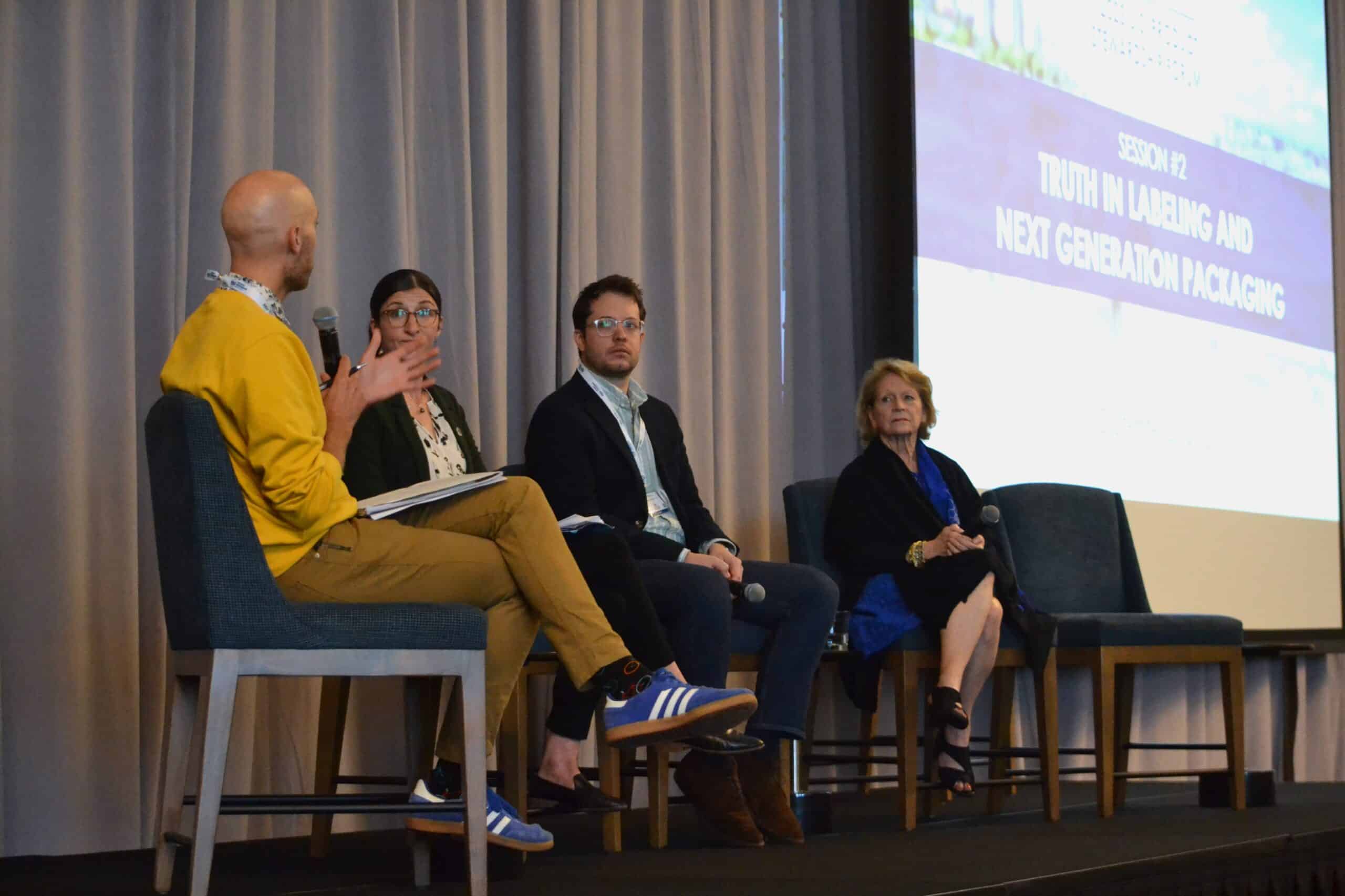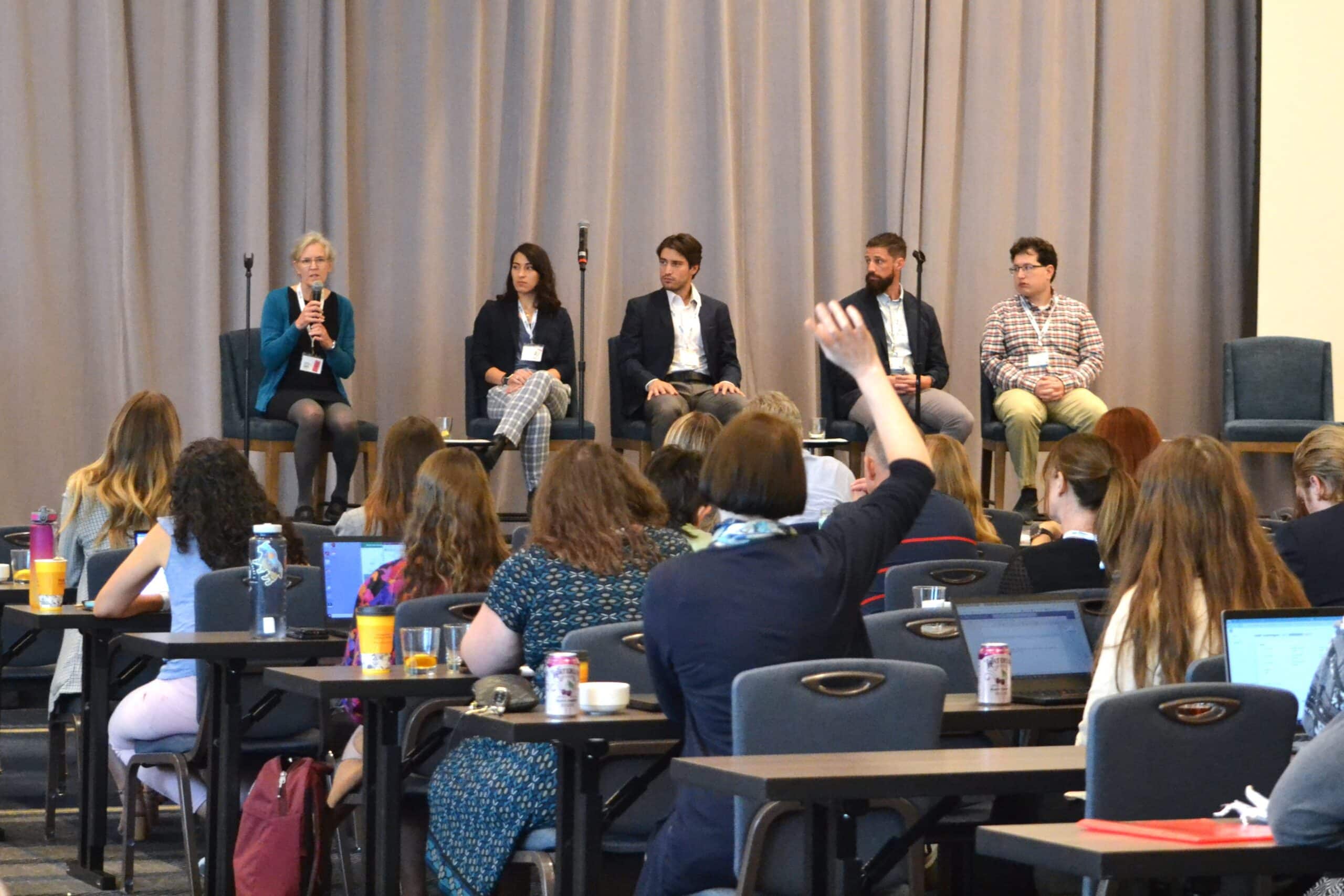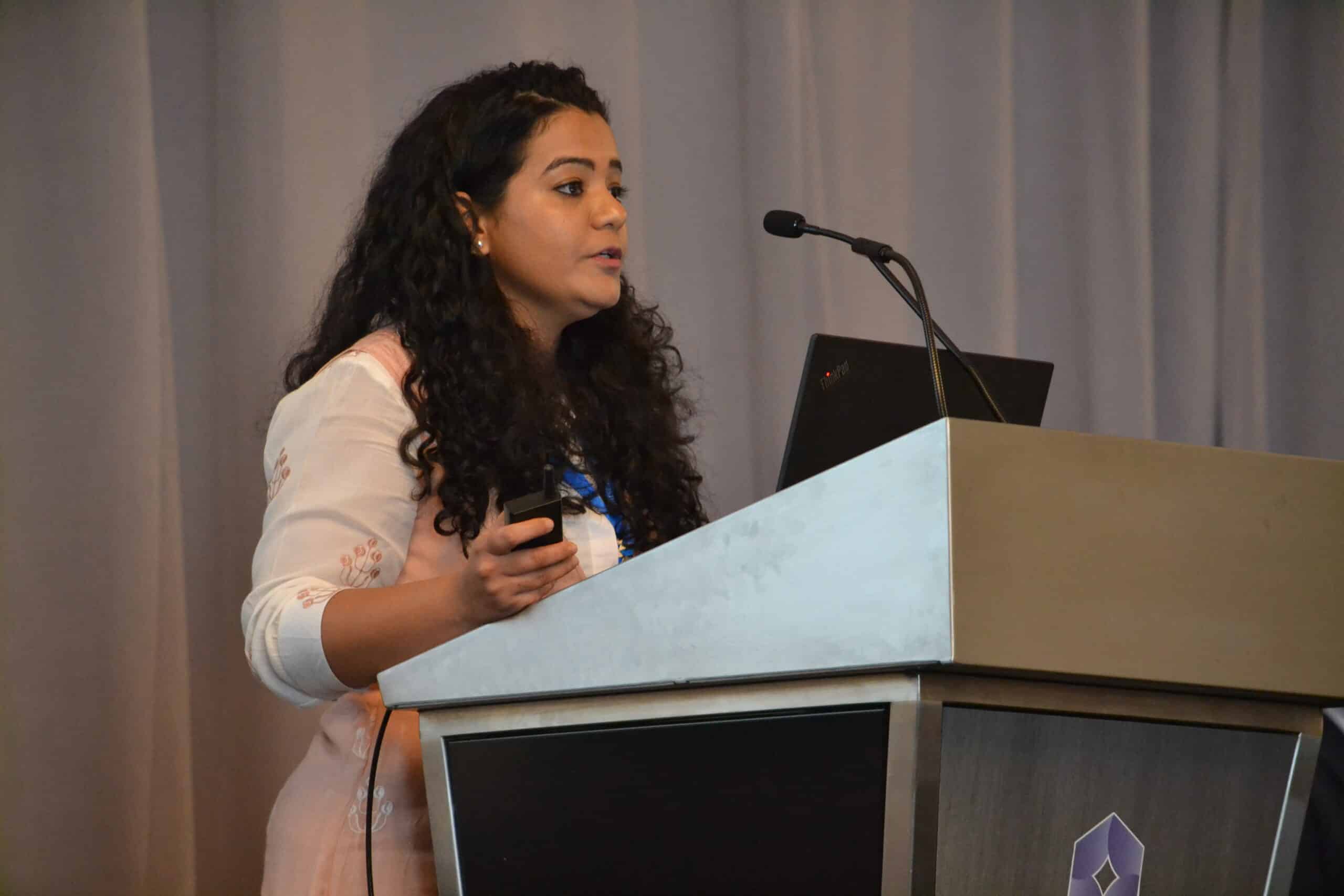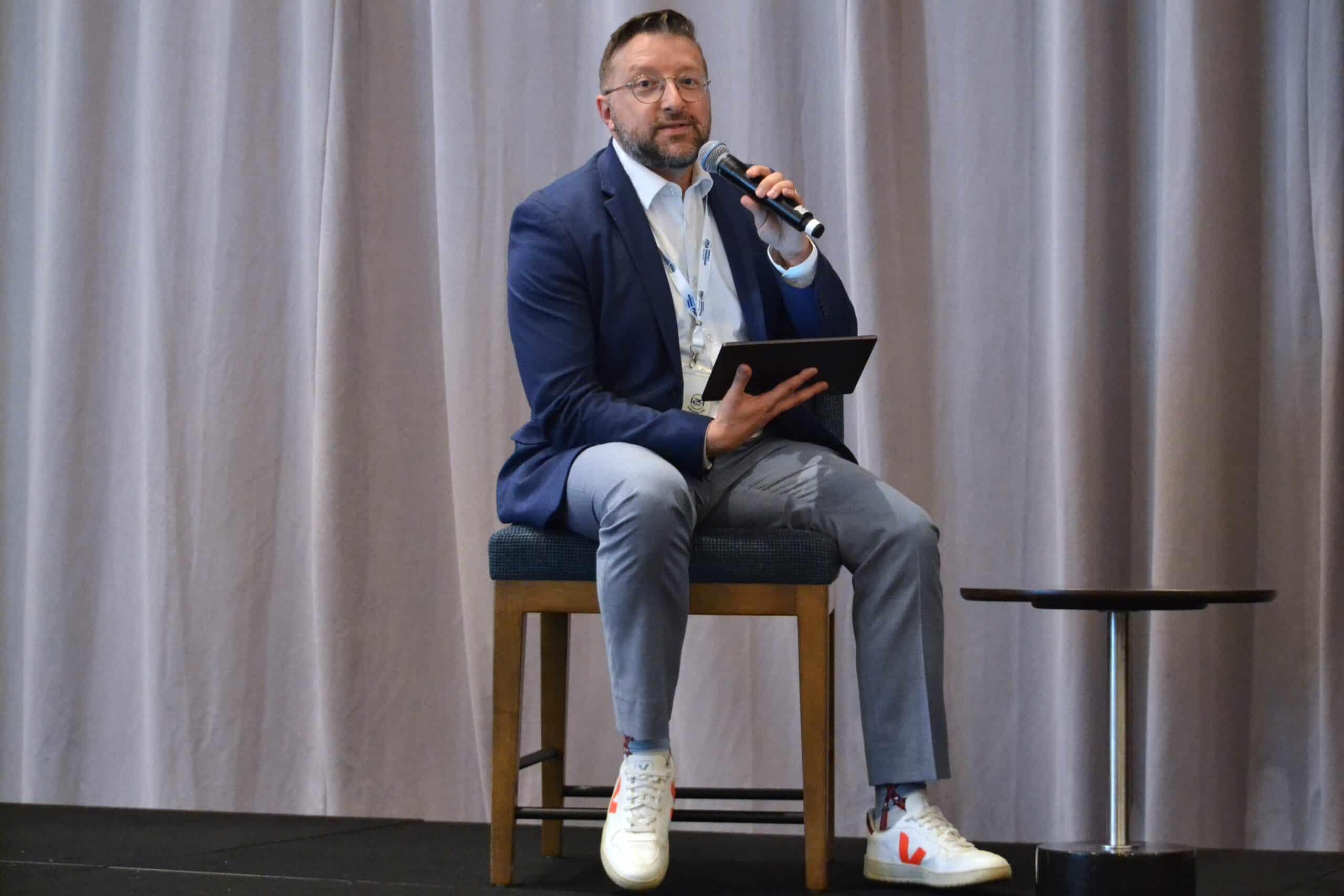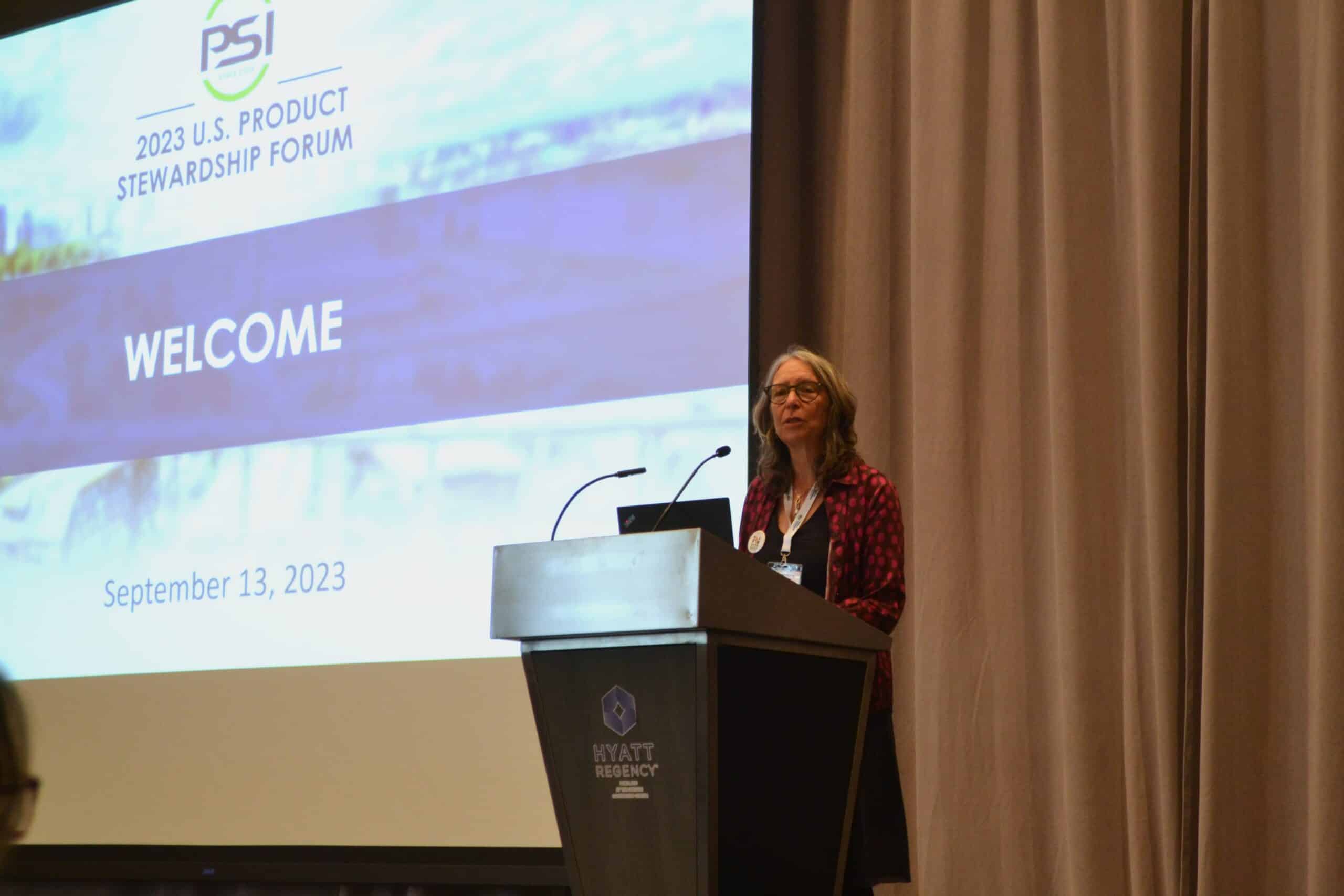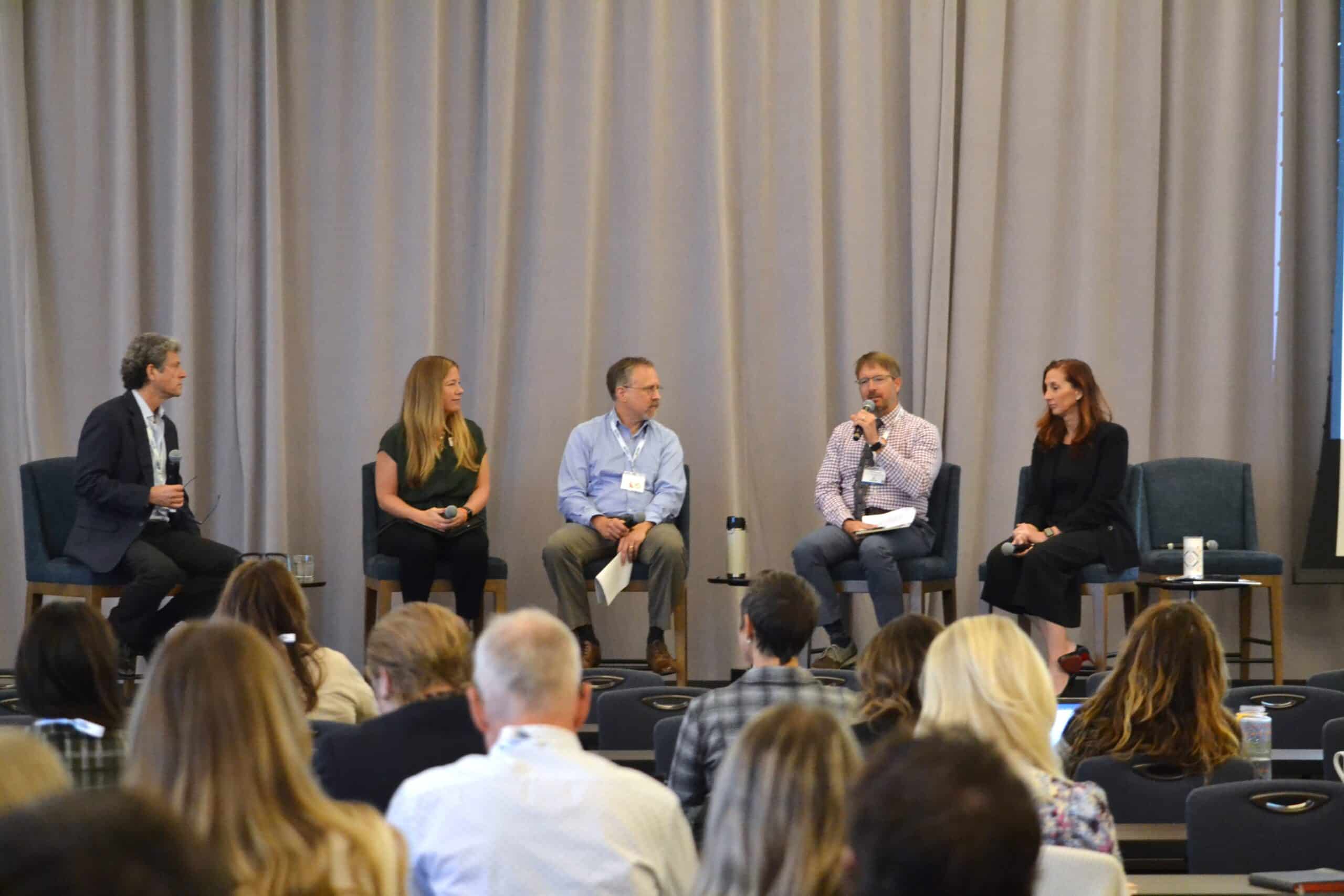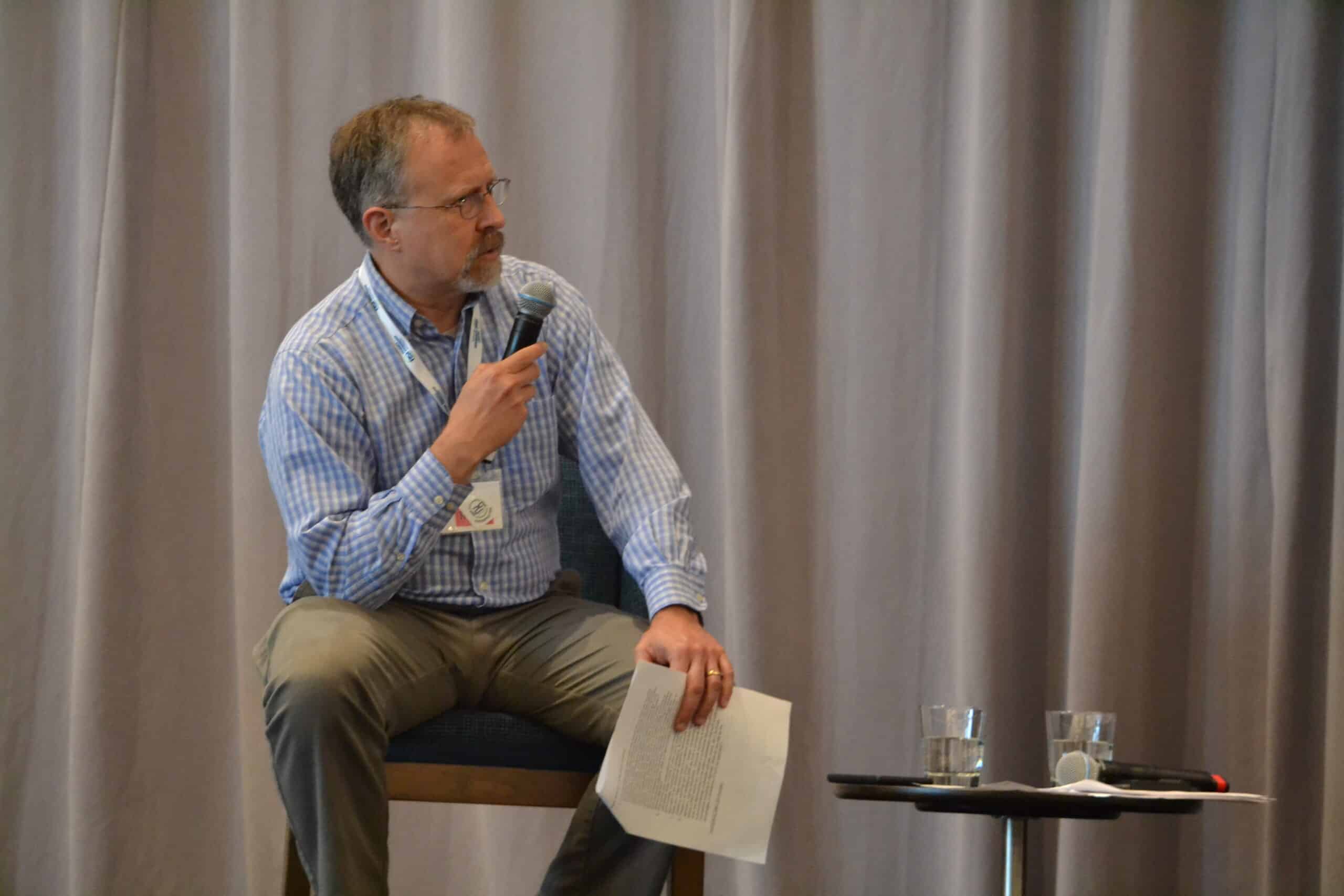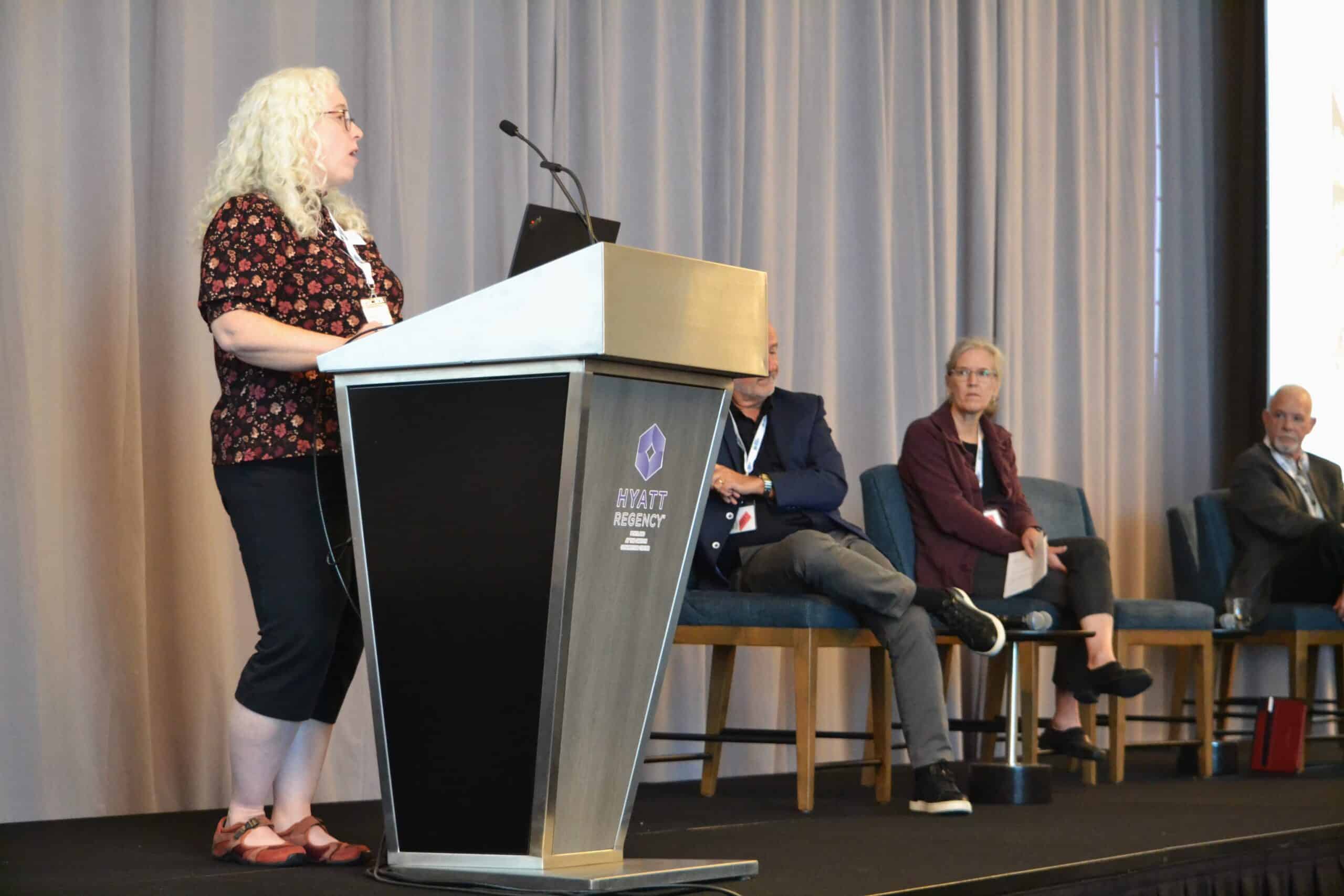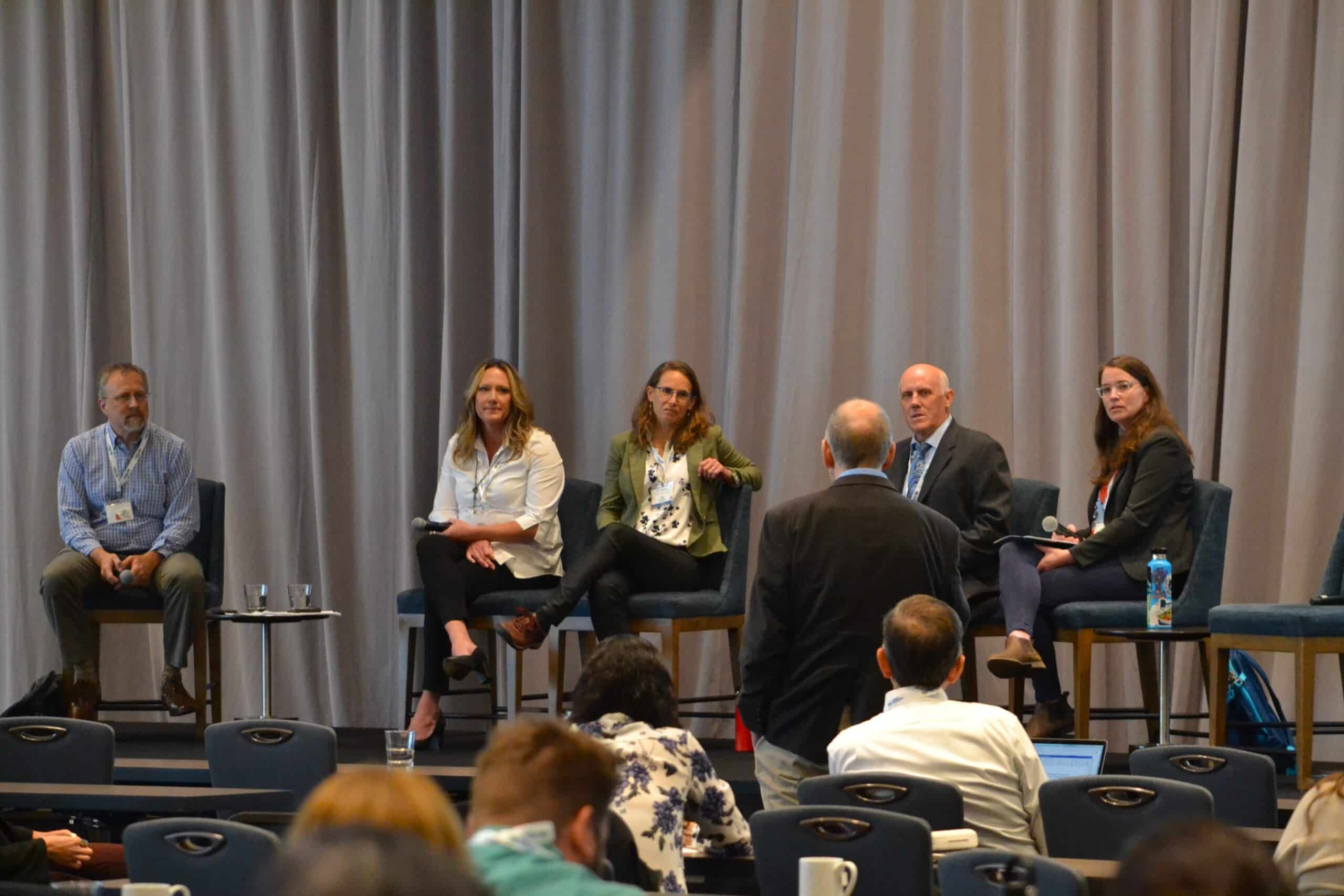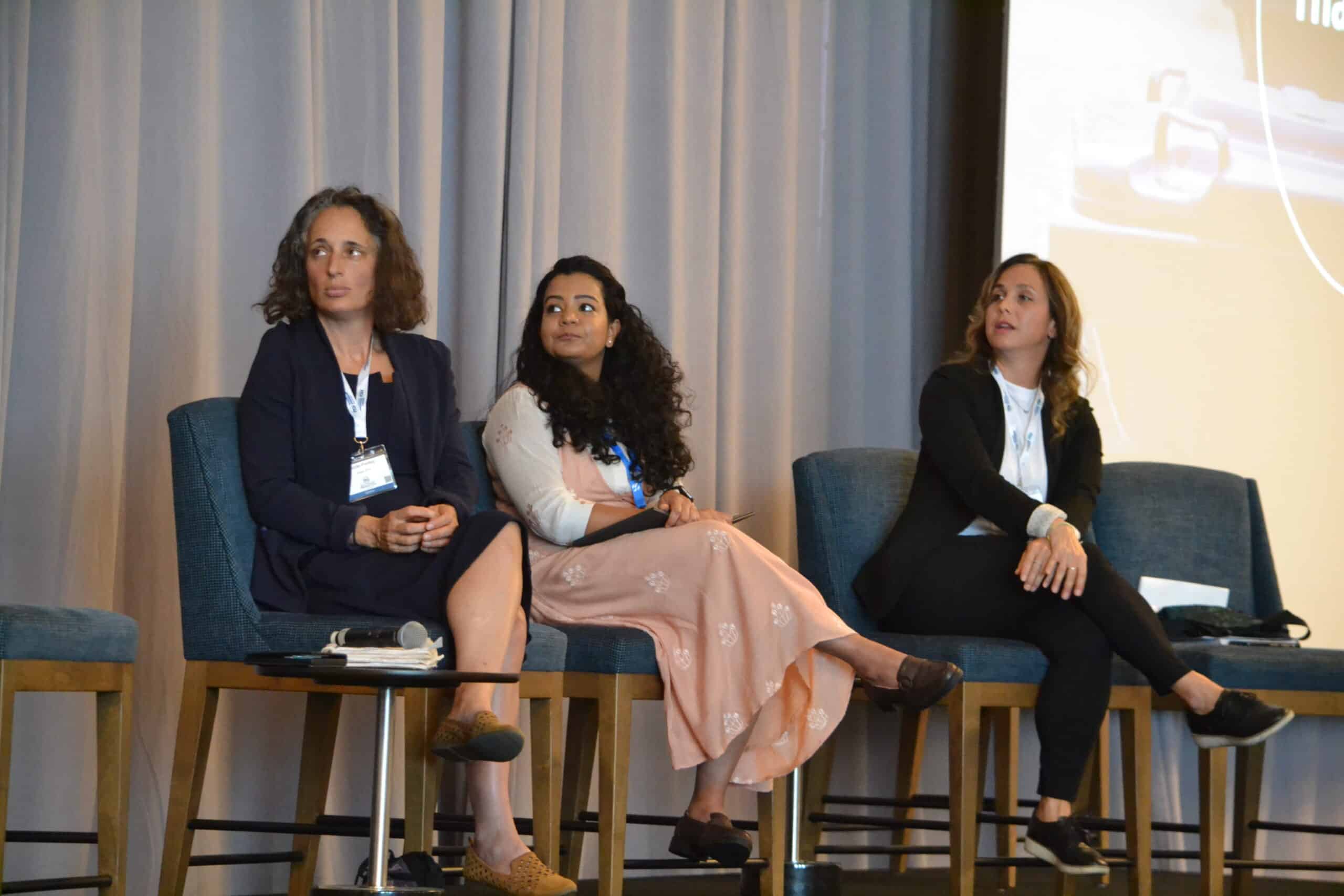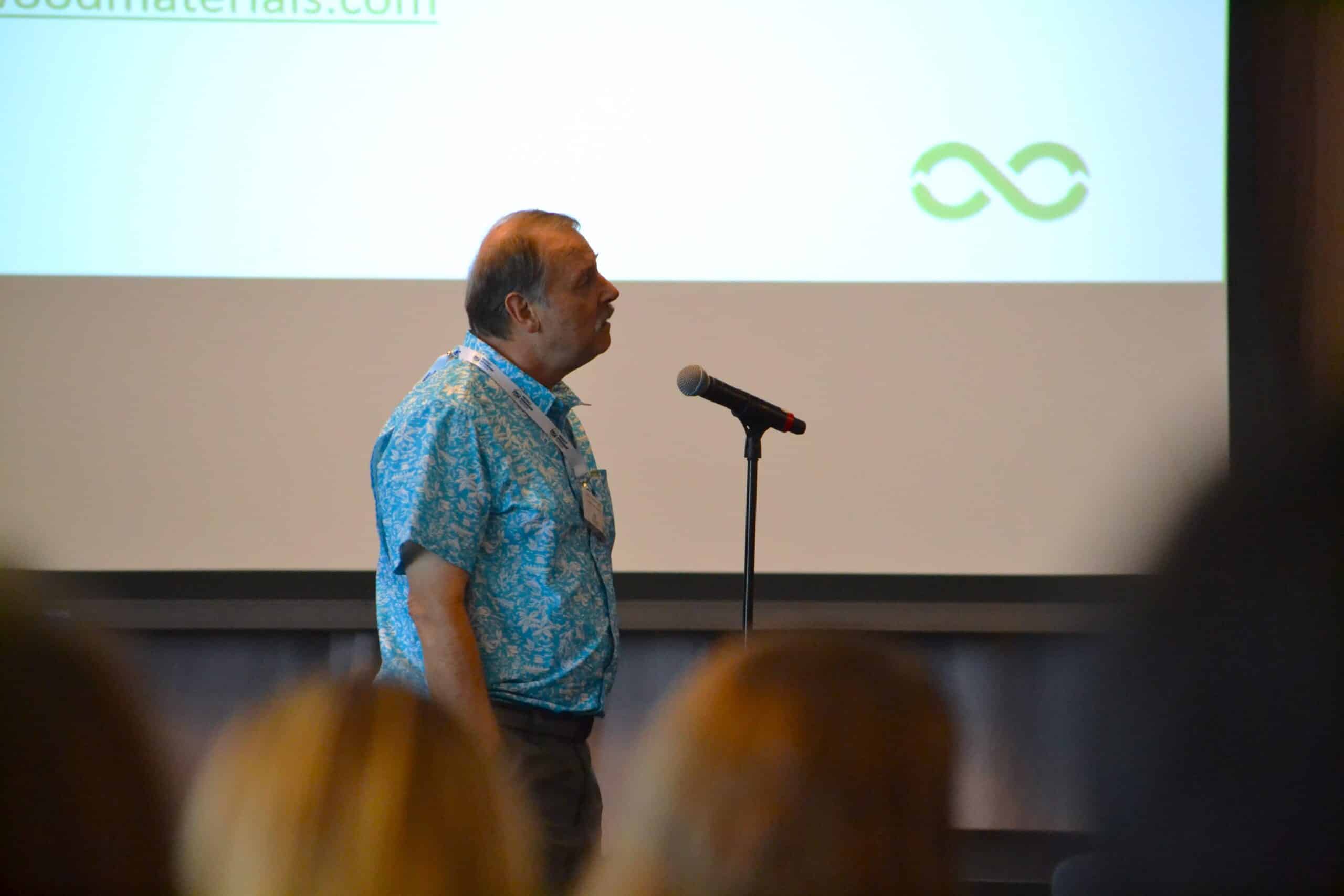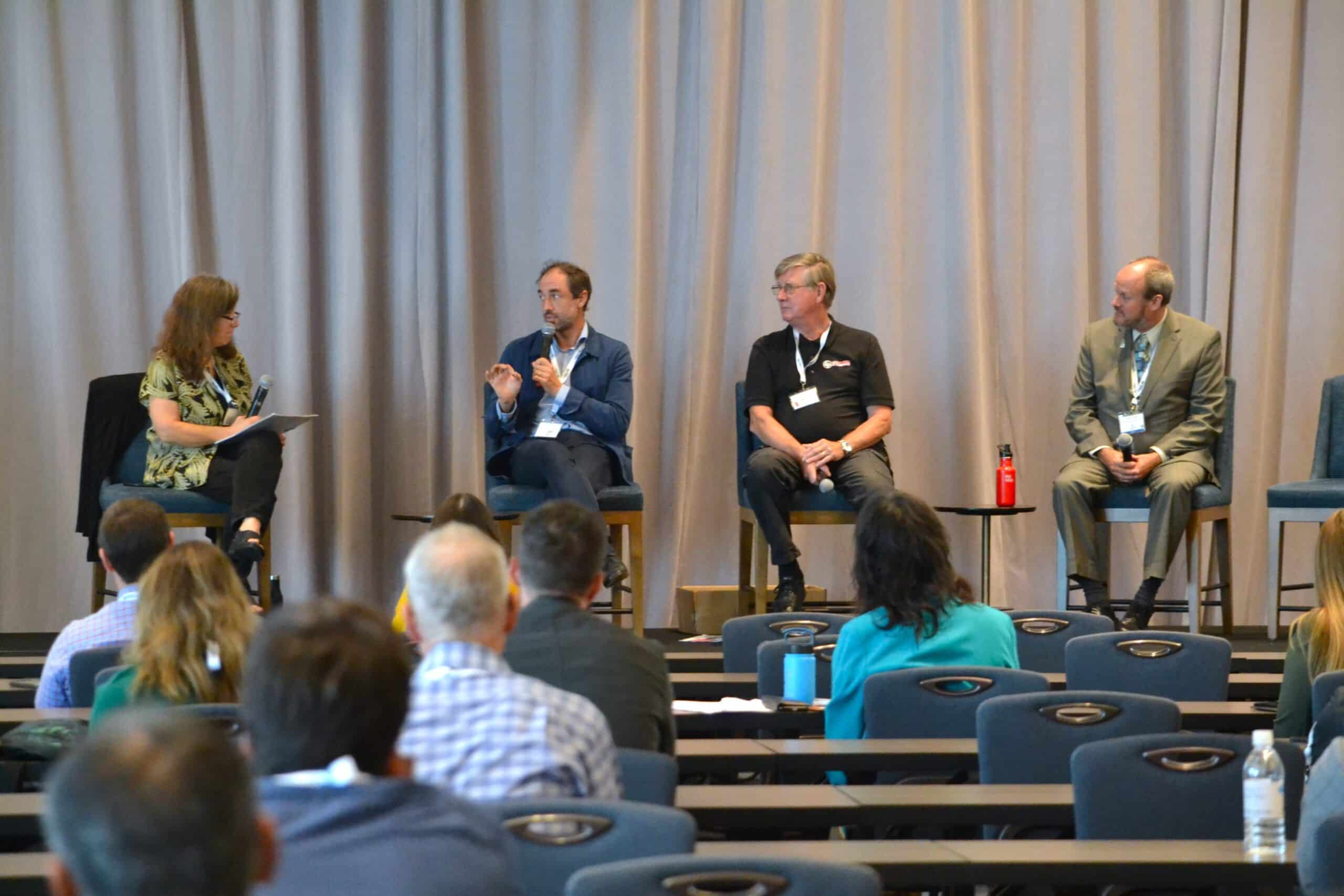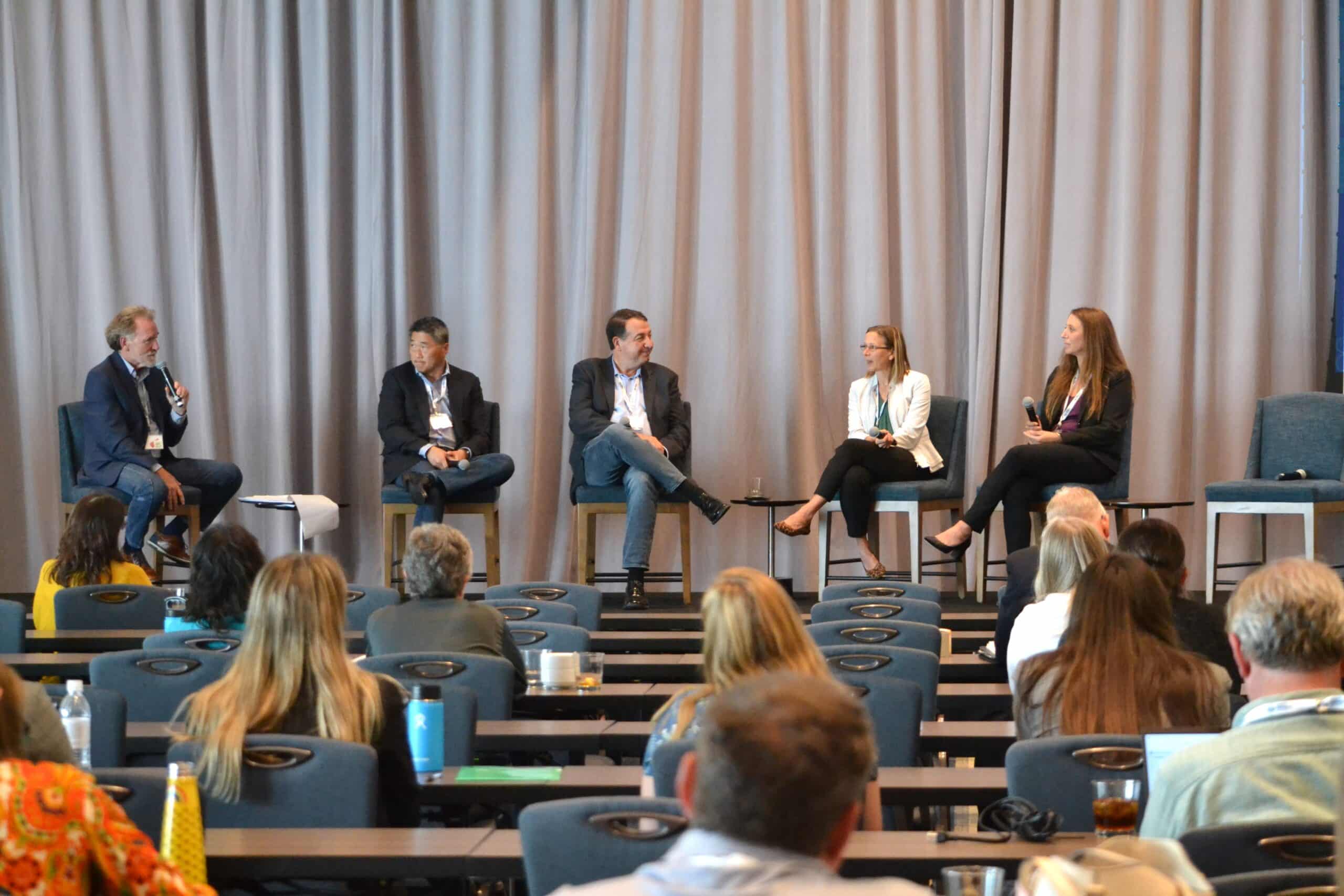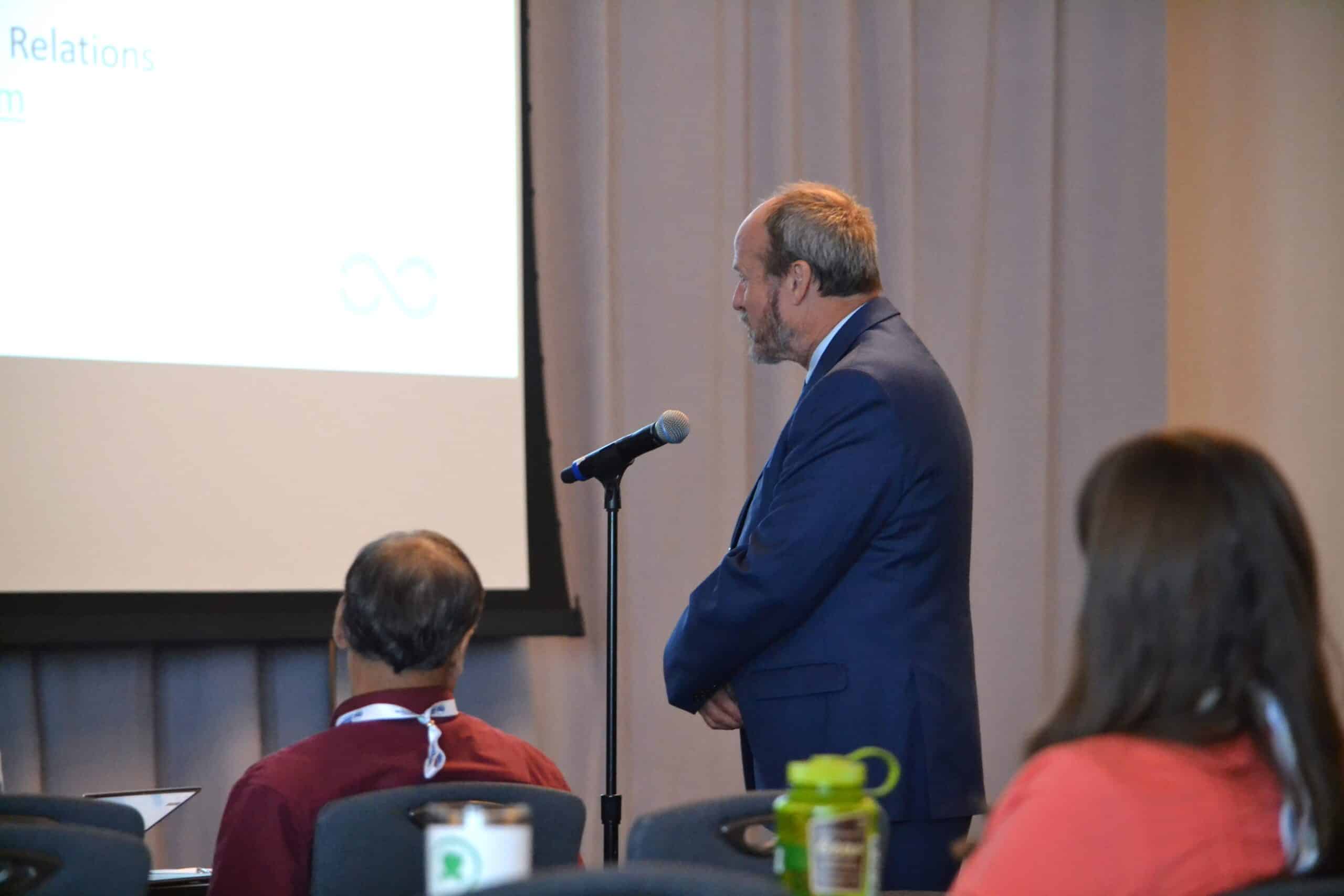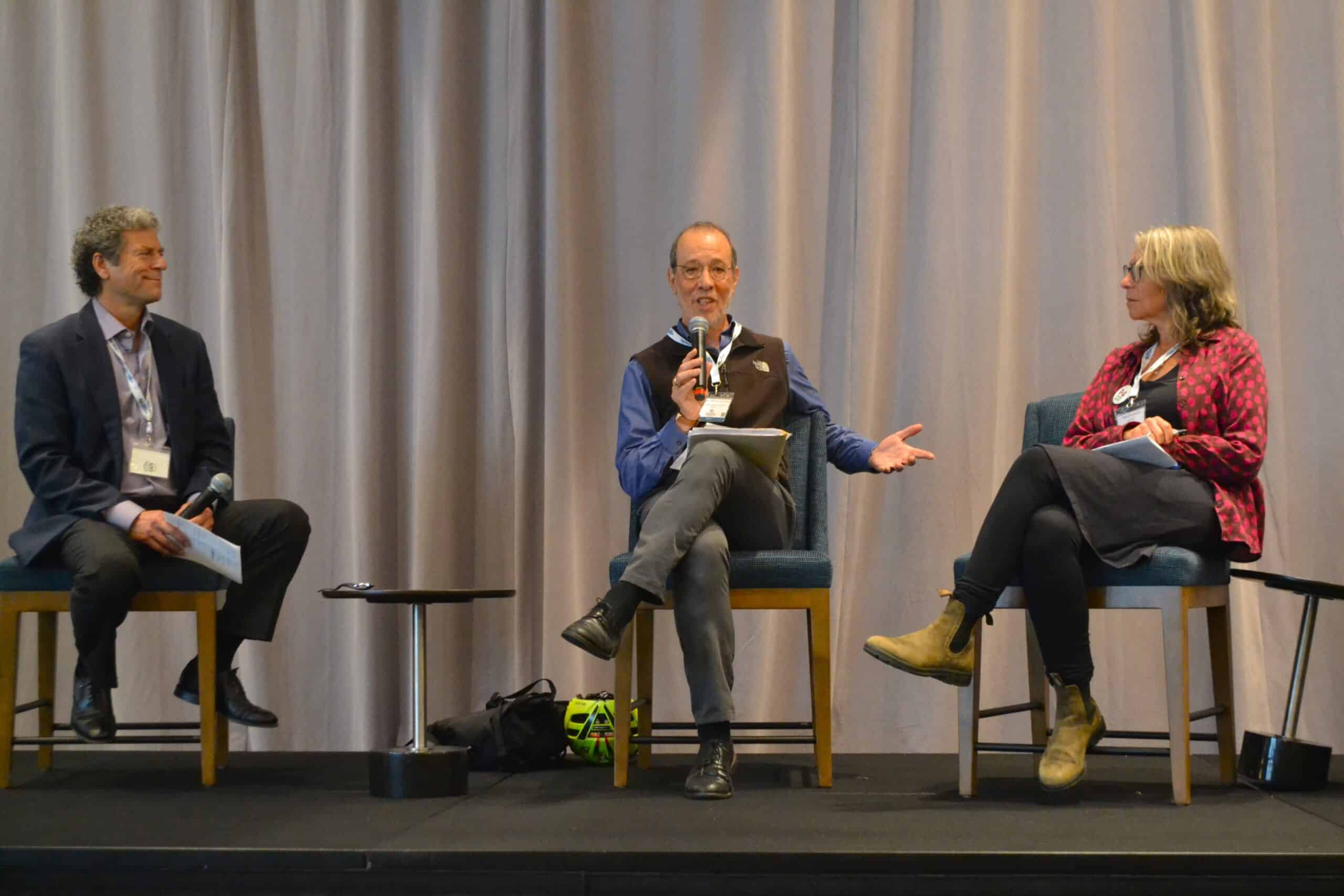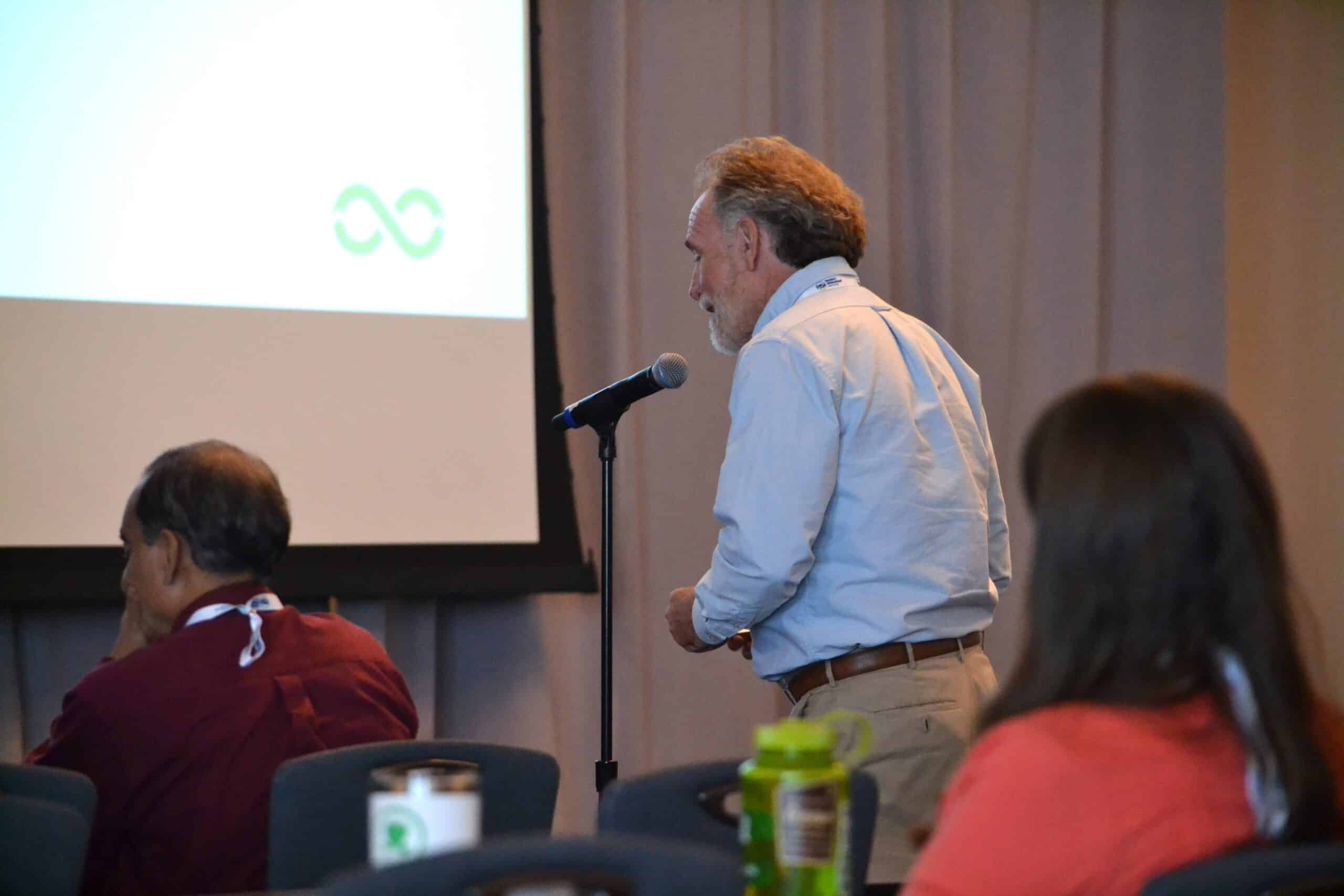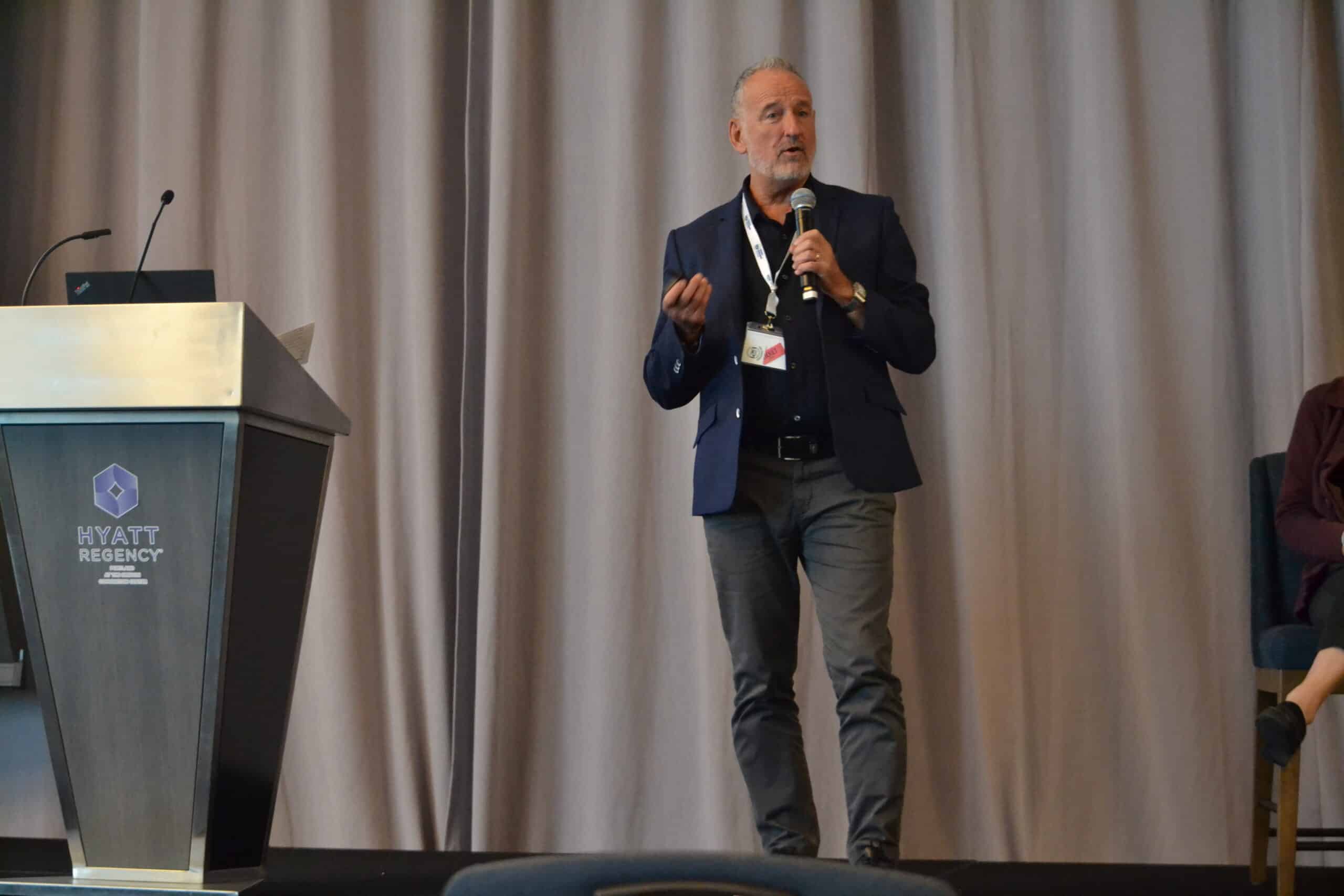Earlier this month, over 200 globally recognized experts gathered in Portland, Oregon for PSI’s 12th U.S. Product Stewardship Forum. Speakers presented throughout two days of intensive sessions on a wide range of topics covering the most important trends in producer responsibility policy and programs. While all of the sessions were insightful and high quality, the following notable quotes were made during a few of the top sessions.
Extending Responsibility: Eco-Modulated Fees and Responsible End Markets
“Eco-modulation must go beyond incentives, it is about making sure the fee structure reflects the real costs of managing the packaging material and its impact in the value chain.”
Genevieve Dionne, Éco Enterprise Quebec
“Eco-modulation works, period. But it could be gentler, and it could be less complicated for the producers and other market players.”
Gauravi Saini, Reclay StewardEdge
Perspectives on Plastic Recycling – From Mechanical to Chemical
“Mechanical and chemical recycling need to be complementary solutions. The complexities of plastic waste require both to deliver a truly circular economy”
Maranda Demuth, Eastman
“We need to have a robust conversation on whether chemical recycling is worth its environmental impacts.”
Celeste Meiffren-Swango, Environment Oregon
The PRO’s Role in the Circular Economy
“Having a not-for-profit producer-governed organization that supports producers in meeting their EPR commitments ensures efficient and effective recycling systems are in place where plastics and other packaging materials are collected, recycled, and returned back to producers for use as recycled content.”
Allen Langdon, Circular Materials
“We are working with local governments and recyclers to determine how to effectively support recycling systems.”
Shane Buckingham, Circular Action Alliance
“The hallmark of successful systems is a focus on the goals and the desired outcomes.”
Leslie Huska, GreenDot North America
Packaging EPR Implementation in the United States
“The Oregon law prioritizes sustainability above circularity. There is potential for these ideas to be in conflict and the Oregon law aims to achieve broader sustainability objectives. If we pursue circularity in a narrow way and just focus on recycling and composting, there might be some unintended outcomes.”
David Allaway, Oregon Department of Environmental Quality
“In California, we are focused on the reduction of plastic pollution and overall production of packaging materials in the state. The California law requires that 100% of packaging sold into the state of California is either recyclable or compostable, by 2032.”
Rachel Machi Wagoner, CalRecycle
KEY TAKEAWAYS
Throughout the rich and diverse discussions at the conference, the following important issues were highlighted as they are becoming increasingly important in the field of EPR.
- Policy Harmonization: All stakeholders expressed the importance of identifying common elements of all EPR bills and laws. Policy harmonization is not only crucial for increasing the efficiency of existing and future programs, but also for ensuring alignment across jurisdictions, reducing consumer confusion, and enabling effective program comparison.
- Measuring Success: Congruent with the need for policy harmonization is the need to define how the success of a program or policy is measured. It is essential to identify what needs to be measured, ensure that data collection is accurate and consistent, and provide all stakeholders with relevant information.
- Producer Presence: As the field of EPR continues to advance, it will be necessary to directly involve producers, along with associations, in the conversation. Without representation from key producers, a valuable perspective on the field is lost. The interest of individual producers and their associations are essential to advancing effective EPR policy.
WHAT ARE PEOPLE SAYING ABOUT THE CONFERENCE?
We are shifting into a new phase of the EPR movement with rapid success and the need for engaged stakeholders and a highly knowledgeable community. The PSI Forum will continue to be a space for those eager to learn and contribute as we lead this movement forward. Here are some thoughts from 2023 PSI Forum attendees on the importance of event:
“PSI did it again, assembling the world’s experts on EPR (those actually engaged in making it happen) and presenting two days of rich, productive conversations about the current state of affairs in the U.S., Canada and Europe and where things are headed, on a wide variety of products as well as packaging. Kudos to PSI for being able to bring such diverse parties to the conference in a series of stimulating panels. PSI continues to be THE place to go for expertise, ability to bridge government, business and advocacy groups, and the many connections, contacts and synergies possible.”
Dave Galvin, former PSI board president
“PSI’s conference enables State Environmental Staff, PROs, Recyclers and NGOs to collaborate on EPR. With the growth of EPR, this conference is becoming essential to those involved with environmental policy and execution.”
David Bender, CEO Circular Polymers by Ascend
“Excellent forum about all aspects around EPR. Competent speakers, lively discussions about the hot topics, engaged participants, perfect networking. The place to go in the US!”
Joachim Quoden, Managing Director EXPRA
“The 2023 US Product Stewardship Forum provided a wonderful opportunity to connect and have meaningful and in-depth conversations with others working to find solutions to how we can move the solid waste industry from a linear (extract, make, use, dispose) system to a more circular economy. Learning from each other and working together, we can take actions that have long-term positive results for our customers and the environment!”
Susan Fife-Ferris, Seattle Public Utilities, Washington
“Fun, productive, and a truly unique meeting of the minds from across the globe!”
Maya Buelow, Lane County Waste Management, Oregon
“Scott and the PSI team put together an excellent event. The structure was just right to allow attendees to choose which sessions they wanted to attend without having to choose from overlapping sessions. Looking forward to the next Forum two years from now!”
Doug Kobold, California Product Stewardship Council
CONTINUE THIS WORK WITH US
PSI will continue to lead these conversations with other experts through our webinar series this fall. Our webinars will cover a range of pressing issues and we look forward to your participation. For more information, sign up for our monthly newsletter.
BOOK NOW AVAILABLE
Scott Cassel, CEO and Founder of the Product Stewardship Institute, debuted his recently published book, Perspectives on Product Stewardship: Navigating an extended producer responsibility path to a circular economy, at the 2023 U.S. Product Stewardship Forum. This book is a must-read for all EPR professionals. Click here to purchase your copy! If you are a PSI Member or Partner, contact info@productstewardship.us for 30% discount.
PHOTOS FROM THE FORUM:
by Scott Cassel, CEO and Founder
This past December, the Product Stewardship Institute (PSI) and the Oklahoma Meds and Sharps Disposal Committee (OMSDC) kicked off a six-month pilot program to increase the safe collection and disposal of medical sharps in Oklahoma. Through the program, residents can drop off or mail back used medical sharps at multiple sites throughout the state for free. A few months in, the program is already seeing tremendous progress — a testament to the vital need for more robust infrastructure and education to deal with used syringes, needles, and lancets.
So far, the collection rate at several program sites has exceeded expectations, with Stop Harm on Tulsa Streets (SHOTS) and the City of Stillwater requesting pickup of collected sharps two months ahead of schedule due to an influx of residents safely disposing of their medical sharps. Another sign of the program’s progress is that most sites have distributed almost all at-home containers and will be ordering more soon. SHOTS has also been invited to collect sharps at a household hazardous waste drop-off event on March 5 in Tulsa.
The success of the take-back program is due to effective outreach by site partners and other members of the OMSDC, not to mention media attention. So far, the program has garnered national and local coverage from multiple news sources such as Waste Today, KJRH Channel 2 News Oklahoma, the Tahlequah Daily Press, and the Oklahoma State University Extension. Plus, the Oklahoma Recycling Association highlighted the program in a Facebook Live. The Oklahoma Department of Environmental Quality (DEQ) also recently released a video promoting the program.
The significance of the program is twofold: not only does it provide convenient options for residents, in doing so it also protects public health and the environment. Improper disposal of medical sharps poses severe health and safety risks for families, sanitation workers, hospitality workers, and many others, in addition to polluting local parks, streets, and waterways. Nationwide, 7% of needles are flushed, and an estimated 3 billion sharps enter the municipal solid waste stream each year as trash.
“Most of us don’t have to think about medical sharps,” said Lelande Rehard, PSI’s senior associate for policy and programs. “But if you use sharps, are a frontline recycling/waste employee, work in public health, or coordinate regular litter cleanups, then you understand the importance of tackling this small but difficult material. The safe disposal of medical sharps is an environmental, safety, and social justice issue.”
PSI is already working on plans to expand the take-back program to new sites in the future. In particular, PSI is eager to create sharps collection sites in Native Nations and is pursuing funding to do so. Safe sharps disposal infrastructure in Native Nations is sparse despite the disproportionate number of Native Americans with diabetes — who likely use sharps — compared to white residents.
The current six-month take-back program continues to run now through mid-May 2022 or as long as supplies last. For more information about the program and where to safely dispose of medical sharps, visit bit.ly/OKsharpspilot.
The pilot is supported by a solid waste management grant from the Oklahoma Department of Environmental Quality.
This question is one we continually challenge ourselves to answer so that we stay on the cutting edge of the U.S. product stewardship movement. As we embark on a new decade full of opportunity for EPR, we want to ensure that the research, projects, legislative models and laws that we craft continue to be relevant.
PSI reflects the strength of the individuals and entities who embody the movement. While we have evolved, we stay close to our inner core. We bring together multiple parties with diverse interests to develop comprehensive plans to solve big waste management challenges. We are problem-solvers who base our policy recommendations on sound science, experience, and peer review. We advocate for product stewardship solutions that are shaped by our long list of members and partners. We are systems thinkers who dissect problems and craft solutions from various angles – environmental, economic, technological, political, and communication with the public. We understand the big picture context as well as the individual parts of resource consumption problems. Above all, we have maintained an ethic of credibility and personal responsibility while leading the U.S. product stewardship movement for the past 20 years.

Like all movements, ours would not have taken hold without the energy, skills, and advocacy of thousands of people, including those government officials in the northwest – Oregon and Washington – who were the early pioneers. The success we have jointly achieved has required policy innovators in state and local governments who risked agency rebuke to forge beyond the status quo. It took corporate talent who leveraged their social capital to look beyond pure profit to engage with others. And it took environmental activists who could share an agenda with other players to achieve joint goals.

At PSI’s inaugural conference in December 2000, more than 100 state and local government officials from 20 states came to Boston to learn about a new concept for holding product manufacturers responsible for financing and managing post-consumer products. That meeting sparked a national movement.
Today, 119 EPR laws have been passed in 33 states on 14 products, and 2019 was a banner year for the U.S. product stewardship movement. A record 50 EPR bills were introduced in 16 state legislatures across the country. Of those bills, 12 passed into law, one committed a legislature to introducing a bill in 2020, and four mandated studies that include EPR as the central solution.
2020 promises to be a critical year for the movement. Packaging bills will be introduced or discussed in at least eight states, and EPR bills on pharmaceuticals, paint, carpet, mattresses, artificial turf, and batteries are already being actively debated. And PSI is right in the middle of it all. We now look forward to the future with renewed passion for progress.
On September 8-10, in Portland, Oregon, PSI will celebrate our 20th Anniversary at the national U.S. Product Stewardship Forum. We are already hearing from colleagues who plan to attend from across the U.S., as well as from Germany, France, England, and Chile. We will acknowledge our roots, assess the growing U.S. and global EPR movements, and plan for the next 20 years of growth. We hope to see you there.

by Megan Byers
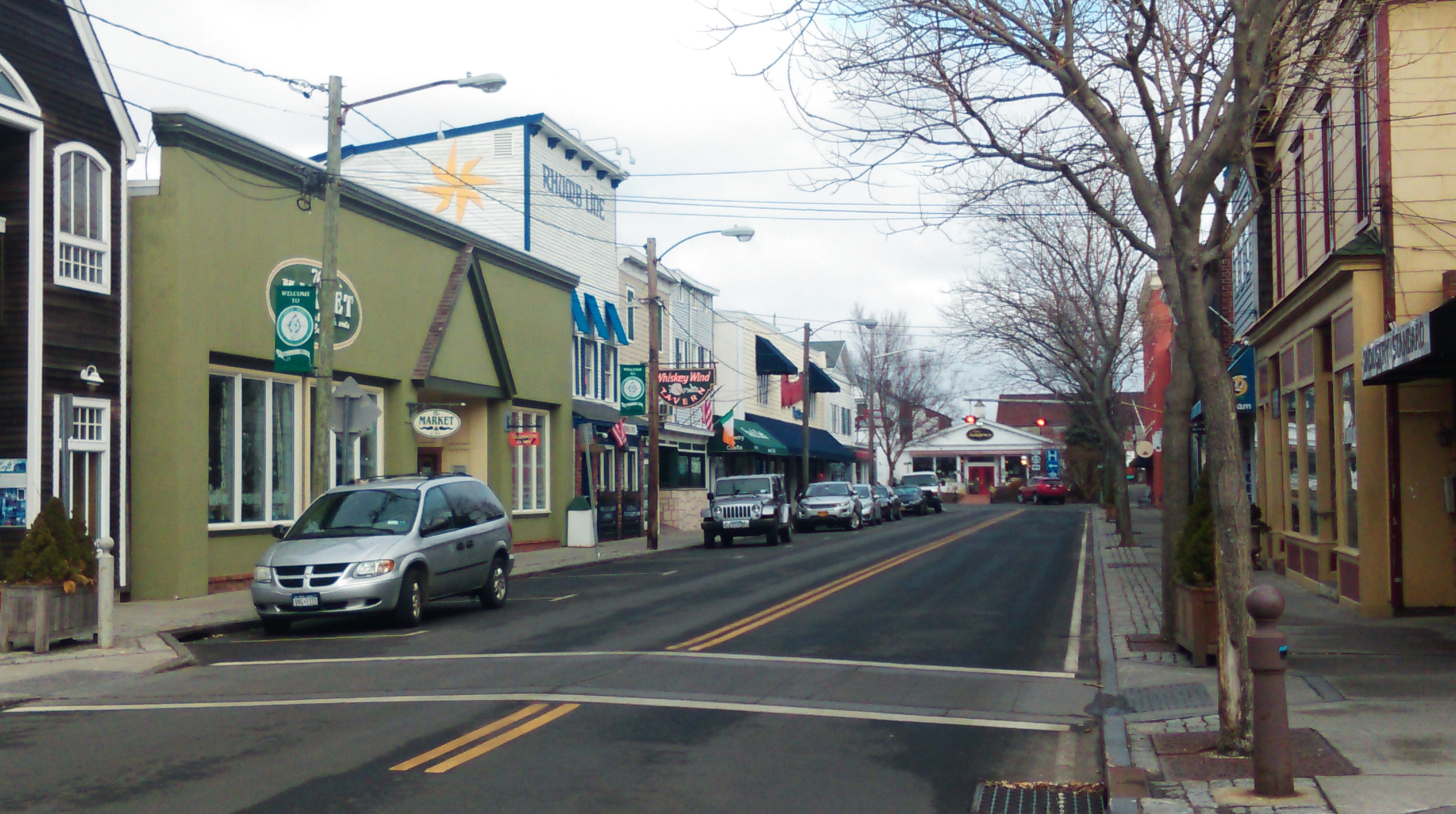 Greenport, NY is a charming seaside village on the North Fork of Long Island.
Greenport, NY is a charming seaside village on the North Fork of Long Island.
A few weeks ago, my colleague Vivian Fuhrman and I traveled to the North Fork of Long Island to kick off the Product Stewardship Institute (PSI)’s Trash Free Waters project, a voluntary plastics source reduction initiative funded by the U.S. Environmental Protection Agency, Region 2 and administered by the New England Interstate Water Pollution Control Commission. Through this initiative, PSI is partnering with four local eateries in Greenport, New York – Alices’ Fish Market, Bruce & Son, Lucharitos, and Tikal.1 – to help them voluntarily decrease the disposable plastic items (cups, straws, take-out containers, etc.) that end up on Long Island’s beaches.
When we arrived in the North Fork, gratitude and support for the project appeared from some unexpected sources.
Vivian and I first presented the project to the Southold Town Board – an opportunity made possible thanks to Southold’s Solid Waste Coordinator, Jim Bunchuck. Our goal was to lay the groundwork for developing a model municipal plan to reduce marine debris on a community level. During the discussion, the Board offered a creative idea: they suggested we create a “Trash Free Waters” emblem that the businesses can display in their windows or on their menus to market their marine debris reduction efforts.
Later that day, we met the participating businesses in the Greenport School for our kickoff meeting. Thanks to the meeting location, teachers Stephanie Pawlik and Brady Wilkins were able to join us and eagerly volunteered to have their students design the “Trash Free Waters” emblem as part of an environmental unit in class. A local artist, Cindy Roe, later contacted PSI and offered to advise the students and judge the submissions. We are now finalizing a plan for the emblem and connecting these volunteers.
Within the following week , at least three local news sources (SoutholdLOCAL, Suffolk Times, and North Fork Patch) published articles about the project. Thanks to this press, the project received many positive comments on social media – in fact, several individuals even suggested their own ideas for reducing plastic pollution!
This sort of community collaboration is a key aspect of protecting our planet. The support we are finding in Greenport is a reminder that, no matter who you are, everyone has their own unique ability to stand up to protect our waterways.
Regardless of the product focus, multi-stakeholder collaboration is a key tenet of PSI’s approach to product stewardship and has been critical to our success. For instance, to address economic and environmental problems caused by leftover paint, PSI facilitated a national group of state and local governments, paint industry representatives, retailers, recyclers, non-profits, and others. After years of research and discussion, that national group created a model paint stewardship bill that now serves as the basis for nine paint stewardship laws passed in the U.S., resulting in 16 million gallons of paint being diverted from disposal, saving governments and taxpayers over $69 million, and creating over 200 jobs.
Marine debris is a visible problem in coastal communities like Greenport, and now a wide variety of stakeholders are ready to address it. PSI knows that this fortuitous synergy from multiple stakeholder groups will boost the participating eateries’ visibility, value, and connection to the community, and that their voluntary plastics reduction effort may serve as a starting point for community-wide action to reduce marine debris.
As a complement to PSI’s Marine Debris Reduction Toolkit for Colleges & Universities, PSI’s work with the Greenport eateries will culminate in a Marine Debris Reduction Toolkit for Eateries that will help businesses and municipalities across the country reduce their contribution to marine debris.
Megan Byers is the newest addition to the Product Stewardship Institute (PSI) team. She focuses on packaging, tracking legislation, and communications work at PSI, and coordinates several state product stewardship councils. She’s leading PSI’s Trash Free Waters project.
By Dave Galvin, Hazardous Waste Program Manager at the King County Local Hazardous Waste Management Program
To flush or not to flush? This is a question many of us have faced over the years. Those who live with on-site septic systems are particularly sensitive to the quandary of what goes down the drain. Anything other than human waste and toilet paper (that is specifically made to break apart almost immediately) should be kept out of such systems, especially if there are small pumps involved along the way, which can easily clog. After you’ve had to clean a clogged pump or pipe by hand, your sensitivity to such matters goes up exponentially.
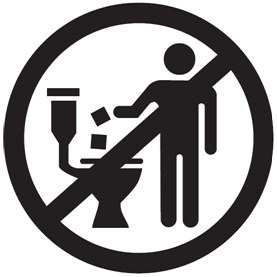
Some consumer products are labeled as “flushable,” but are they really? Items such as baby wipes and skin cleaners, paper towels, feminine care products, condoms, diapers, and even dental floss, are usually not designed to break apart immediately and are thus not intended to be flushed. Some wipes are marketed as “flushable” while others as “disposable”; they are made by the nonwoven fabric industry and are supposed to meet certain voluntary guidelines developed by this industry.
A group of wastewater and water quality associations is meeting with representatives of the nonwoven fabric industry (via a trade association known as the International Nonwovens and Disposables Association) to explore a “product stewardship approach.” What, you ask? Take-back of leftover wipes? No, let’s not go there. Instead, they have agreed to discuss the challenges that the wastewater agencies face and to tighten the requirements spelled out in the current Guidance Document for Assessing the Flushability of Nonwoven Disposable Products (third edition). A fourth edition is currently in the works.
Here is an instance where the product stewardship dialogue actually addresses design standards! How do you set criteria for flushability such that the product truly breaks down in ways that are compatible with on-site and municipal wastewater systems? How do you ensure that these products are truly acceptable to flush, that they are “biological nutrients” in McDonough and Braungart’s Cradle-to-Cradle sense? How do you establish clear and meaningful labeling and marketing standards for what is flushable and what is not? Interesting questions indeed, and a dialogue sure to blaze new territory in the product stewardship universe.
This discourse illustrates an expanded definition of product stewardship, one that covers the full lifecycle, including design and labeling decisions that affect end-of-life disposition. Who knows – maybe Scott Cassel should be invited to the “World of Wipes” international conference to expand the idea of what it means to affect sustainable product stewardship.
“Hard to handle” takes on new meaning where upstream meets downstream.
Dave Galvin is a Program Manager for the Hazardous Waste Management Unit in King County (Seattle, Washington), part of the multi-agency “Local Hazardous Waste Management Program in King County.” This program addresses household and small business hazardous wastes in the Seattle metropolitan area. Dave began working in this subject area in 1979 and was the one who coined the term “household hazardous waste.” He was the founding president of the North American Hazardous Materials Management Association and was previously the president of the Product Stewardship Institute’s Board of Directors. For additional information, Dave can be reached at Dave.Galvin@kingcounty.gov.
After 14 years, I have a newfound appreciation for PSI’s dialogue process.
The first time I put it to use was in the 1990s while serving as the Director of Waste Policy and Planning for the Massachusetts Executive Office of Environmental Affairs. I was on a mission to increase the recycling of used motor oil in the state. To accomplish this goal, I did what made the most sense to me at the time:
- I developed a technical background document on the issue;
- I met individually with key stakeholders;
- I brought all stakeholders together for a structured dialogue; and
- I mediated a bill with full stakeholder input.
As it turned out, the Massachusetts Petroleum Council (MPC) honored me not long afterwards as “Bureaucrat of the Year.” (They had actually intended that to be a compliment!). It was one of the first times that the MPC had come to an agreement with the state’s two leading environmental groups – the Massachusetts Public Interest Research Group (MassPIRG) and the Environmental League of Massachusetts (ELM).
Of course, the agreement was not my doing. It was only possible because experts from MPC, ELM, MassPIRG, and other key stakeholder groups were so skilled at representing their constituencies and understanding the issue of used motor oil recycling. They just needed a conductor.
Fast forward to today, in my role of Chief Executive Officer of PSI, and I still follow the same process that I first developed and put to use in the 1990s! It made the most sense to me then, and it makes the most sense to me, now. PSI is, after all, more of an orchestra leader than a virtuoso performer. We blend the range of stakeholder interests to achieve a solution that is sustainable – it’s all about money, jobs, and the environment.
What we want
Yes, PSI has an agenda – we support a strong role for producers. We believe that, in cases where post-consumer products have a negative value – where the cost of collecting and managing that product is greater than the value derived from its resale – legislation is the best way to create a level playing field that is fairest for all market competitors. However, we are pragmatists who seek negotiated solutions within the parameters of a large product stewardship arena.
PSI takes its cue from the expert “performers.” We attempt to meld progressive environmental group interests with risk-averse business interests – all while operating under the auspices of an organization that represents state and local government agencies that serve the public interest. We identify waste management problems, define a product-focused problem jointly with other stakeholders, seek joint goals, determine barriers to achieving those goals, identify possible solutions, and facilitate discussions to seek a common solution. Our understanding of waste management, bolstered by our network of members and partners, runs wide and deep, equipping us with both a bird’s eye perspective of the “big picture” and a unique knowledge of on-the-ground issues.
As it turns out, a state and local government forum offers one of the best opportunities for a fair and balanced discussion among divergent stakeholder groups. It excels at raising and resolving issues – resulting in reduced waste, more recycling, new jobs, and lower costs for governments and taxpayers.
The secret ingredient
The reason is fairly simple. PSI has an essential element: 47 state member agencies and hundreds of local government members that are on the front lines of managing waste. We take our lead from these officials, and many are in a position to impose legislated solutions on manufacturers. This unique political dynamic benefits not only governments, but also companies that wish to avoid having to juggle compliance with 50 different programs in 50 states. Over the years, I have watched other stakeholder meetings fall short of achieving their goals, and most times, it was for one or more of the following reasons: 1) not all key stakeholders were represented; 2) not all key issues or viable solutions were discussed; 3) the problem was ill-defined and/or the goals were not well-articulated; or 4.) the meeting did not foster the necessary political dynamic.
On June 11-12, PSI will convene a forum of stakeholders to increase the recycling of single-use and rechargeable batteries by developing model legislation. PSI’s effort will begin the nation’s first attempt at developing a model legislative solution for both battery types, with the support of both battery industry associations. Although there are many tough issues to resolve, all battery manufacturers share the desire to increase the recycling of their batteries. How we do it is key, and finding the right path will require the blending of multiple interests.
On May 11-12, PSI will convene a similar first-time forum to increase the recycling of scrap carpet by developing model legislation. Although carpet manufacturers fully support the goal of increasing recycling, they prefer a voluntary approach and oppose legislation. Increasingly, however, PSI is gaining the support of other product manufacturers for an EPR legislative solution—perhaps because of our ability to integrate their interests with those of our government members. The paint industry was the first to recognize the benefit of working with a national organization to develop a state-based model that could be rolled out nationwide. We hope to replicate that success with carpet, batteries, and other industry groups.
What does the future hold?
As the years go by and companies understand that money can be saved, jobs can be created, and waste can be reduced through EPR laws, opposition will surely erode and support will grow. It is inevitable because that is the writing on the wall. The only question is how painful or prosperous that journey will be along the way. Will poor laws be created that result in fewer benefits, or will strong collaborative efforts lead to effective laws with maximum benefits for all?
I will put my eggs into the collaborative basket, not because of blind faith, but because of the public and private conversations that I have every week with corporate officials who want to address the real waste management problems of our society. They want to do whatever it takes to change our world for the better, for their kids and grandkids, and for themselves. But this will require more product manufacturers to seriously engage in EPR legislative discussions.
The good news is that history tends to repeat itself. Much in the same way that PSI has experienced growing success with the same dialogue process that I started more than 20 years ago, I am confident that industries will, one by one, come to the table the way MPC did in the 1990s. The way the paint industry did in the 2000s. The way the battery and mattress industries are doing right now.
When the day comes that PSI orchestrates an open dialogue with all industries and government, well… you’ll have never known a happier (former) Bureaucrat of the Year.
–S.C.
I stared at the faces – perhaps one hundred individual photos, side-by-side – of all ages, sizes, and colors – cut down by the ravages of prescription drug abuse.
For the most part they were ordinary people, like you and me. A few fit the stereotype drug addict depicted on TV – disheveled, worn beyond years, tired, and glazed. But most were the epitome of success, gleaming with promise and potential.
As I gazed into their eyes in the lobby of the Omni Orlando Resort at ChampionsGate, which hosted the 2013 National Rx Drug Abuse Summit, the importance of our work on leftover pharmaceuticals solidly hit home. I can help prevent a death. I can help save a life. In fact, we can all help prevent drug abuse, and the death and destruction that appear in its wake.
I understand the over-simplicity in my statements. Every person carries historical baggage, and for some people, it may seem just too complicated, too heavy, too difficult, and too much to bear. All the support in the world might not help at times. But we can remove barriers to the chance for a healthy life, and provide needed support. One of those barriers is that too many drugs are lying around the home when they should be cleaned out and safely destroyed. I do not want to overlook the environmental and aquatic impacts of leftover medications in our waterways. But make no mistake: drug abuse drives the issue of pharmaceutical take-back.
Prescription drug abuse is the fastest growing drug problem in America and has been classified as an epidemic by the U.S. Centers for Disease Control and Prevention. Nationwide, unintentional prescription opioid overdoses kill more Americans than cocaine and heroin combined. A host of federal agencies, including the Drug Enforcement Administration, Environmental Protection Agency, and the Office of National Drug Control Policy, recommend that leftover medicine be brought to take-back programs for safe collection and disposal. So do 43 states.
We know the problem, and we know at least part of the solution. But we also need a way to pay for the means to educate people about the problem of drug abuse, make them aware of the need for safe disposal, and increase the availability of take-back programs. To date, the pharmaceutical companies that make the drugs, particularly addictive opioids like OxyContin and Percocet, have refused to take any degree of responsibility for safely disposing of leftover medications from the home. Not only is there a lack of convenient options to safely dispose of leftover medicine, there is an epidemic of over-prescription.
Two counties have stepped forward to lead a national effort to reverse this trend – Alameda County, California, and King County, Washington. PSI is supporting both of these agencies in their efforts to hold pharmaceutical companies responsible for financing and managing programs to safely collect and destroy leftover home medicines. Thousands of U.S. government agencies support this approach. Provinces in Canada and countries in Europe already successfully and cost-effectively run take-back programs financed and managed by pharmaceutical companies.
PSI is fortunate to have sensed the rise of this issue seven years ago. With the help of many of you, we began the slow, deliberate process of building national support for leftover drug take-backs, changing the federal Controlled Substances Act and associated Drug Enforcement Administration regulations (still in draft form). We are helping to implement the King County law and are setting up voluntary collection sites and raising awareness in rural counties in Washington and Oregon as pilots for national replication. We also finished a three-year project in the Great Lakes, where our coalition developed a model producer responsibility program, created a comprehensive online resource for anyone looking for more information about what to do with their leftover medications, compiled a series of “Lessons Learned” to assist communities nationwide, and created a consumer-friendly info sheet to educate people on what to do with leftover medicine. For these efforts, PSI was honored with a “A Million Thanks” award from Covanta Energy. Personally, I find it rewarding to take part in such worthy efforts, and feel fortunate to have the opportunity.
Please help PSI do more by joining our effort. I have never solicited funds on this blog post before. But the devastating effects of drug abuse are happening right now, right before our very eyes, insidiously belying normalcy. Please consider becoming a PSI partner, making a donation*, or offering a sponsorship* to help us reverse this growing trend. Neil Young sang about every junkie being “like a setting sun.” Together, we have the power to let them see the sunrise.
*To make a donation to PSI or offer a sponsorship, contact Amanda Nicholson at 617.236.4833 or by email at amanda(at)productstewardship(dot)us.
by Tom Rhoads, Executive Director of the Onondaga County Resource Recovery Agency in New York State
We can never get too many good news stories in this day and age. The Chilean miners’ rescue is certain to be one of the top stories of the year for 2010. I was born in a mine town, and although I never spent a full day working underground, I have toured several deep mines. The darkness is absolute when the lights go off. You literally cannot see your hand in front of your face. To be trapped thousands of feet underground is, for me, incomprehensible. To carry any faith in rescue after days of no contact was marvelous and probably a genuine life saver.
I recently read that these miners were harvesting copper ore that was less than one percent copper. Copper is a common metal, but its value has risen enough to drive men 2,300 feet below the earth’s surface. In previous accidents at this very same mine, men died for ore with one percent copper.
Many other metals and minerals are hotly pursued across the globe. Mines in remote Canada and Indonesia have become targets of billion dollar investment takeovers. China made recent world news and sent ripples down economic spines when it declared a suspension to the export of so-called rare earth minerals (those needed in everyday electronics, communication devices, and high-tech batteries and magnets common to many tools and most high-efficiency transportation.)
Can you guess where I am headed? In the United States, only about 60 percent of the U.S. population even has access to basic curbside recycling for containers and printed materials. (USEPA, 2008). In New York, I travel through several areas that offer no curbside recycling for packages, containers, and printed materials. Zero recycling. You see, recycling and recycling infrastructure have a cost. That cost is in addition to the cost of trash disposal. The regional agency I work for, the Onondaga County Resource Recovery Agency (OCRRA), uses the revenues we earn from trash disposal and recovered energy from the trash to pay for the entire program. OCRRA’s disposal fee is more than the cost of landfill disposal, but OCRRA’s tipping fee covers the costs and benefits of Household Hazardous Waste Events, recycling infrastructure, battery collections, free recycling assistance and supplies for businesses, Earth Day Litter Clean-Up, OCRRA’s newsletter, and much, much, more. Even the curbside blue bin for recyclables is paid for with the trash disposal tipping fee. The cost of these programs puts pressure on OCRRA’s tipping fee and the resources of many other local governments providing similar programs. And as we continue to reduce the amount of trash through waste reduction and recycling programs, OCRRA (like many other local governments) is actually penalized for its recycling efforts with reduced revenue in its primary funding source – trash disposal fees.
We constantly reflect on how to pay for waste reduction and recycling programs. But there is a better question to consider: what does it cost us not to recycle? When we send miners into remote and deadly environments, because it costs a little more up front to develop recycling infrastructure, is that really the way to keep score? If China has a lock on minerals needed for the next generation of economic growth or energy-efficient technology, can our children (and their children) really afford us tossing away cell phones, batteries, or old electronics that are far richer in mineral content than ore from a mine?
I hope you agree that these and other similar questions need to be asked when we discuss the cost to recycle, or how to pay for a system that places a priority on reduction, reuse, recycling, and recovery before landfilling. Extended Producer Responsibility laws for e-waste have been tremendous vehicles to fund e-waste recycling infrastructure across the U.S. EPR strategies also have worked in Canada and Europe for other recyclables as well – including packaging and printed materials.
The faith of the Chilean miners to be rescued was probably their life saver. Faith in rescue, leadership during the crisis, oh yeah – and a $20,000,000 rescue effort watched by the world for 69 days; those were the story lines in Chile in 2010. Perhaps we can also consider that product stewardship by the manufacturer (thereby better engaging the consumer) for waste reduction and recycling is the form of leadership needed to avoid another crisis-making headline in the future.

